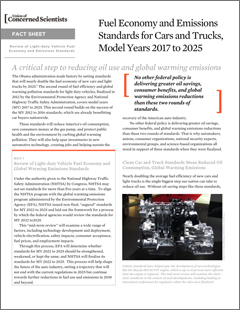In 2012 the Obama administration set fuel economy standards for new cars and trucks—standards that, four years later, remain the country’s most successful climate initiative. No other policy has delivered greater reductions in emissions and oil use—and no other policy offers as many future benefits.
Supported by automakers, unions, national security groups, and environmentalists, the standards (known as the ”National Program”) set fuel economy and global warming emission targets, based on vehicle size, for new cars and trucks sold in the United States. The standards increase in stringency every year and come in two phases: 2012-2016 and 2017-2025. As part of the second phase is a “mid-term review,” designed for regulators to examine and adjust the targets for 2022-2025, based in part on feedback from industry and the public.
To date, the standards have enjoyed enormous success, with unparalleled economic and environmental benefits that are still accruing. The 2017-2025 targets alone will save consumers roughly $50 billion by 2030 and avoid 280 million metric tons of climate pollution in the process—the equivalent of shutting down 82 coal-fired power plants for a year.





